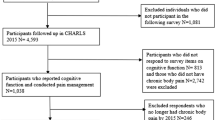Abstract
Background and aims: Pain is a common and unpleasant problem among elderly people and affects the possibility for them to remain living in their own homes. The aims of this study were therefore to report the prevalence of pain reporting and pain treatment, and their association with functional and cognitive status in a very old population. Methods: Cross-sectional population-based study. Participants were 333, aged 84 years or older, living at home alone or with someone in Kungsholmen, in central Stockholm, Sweden. Information on pain was obtained from interviews. The Mini-Mental State Examination (MMSE) measured cognitive status and the index of basic Activities of Daily Living (ADL) functional status. Descriptive statistics were used to describe the population and logistic regression models to investigate factors associated with pain reporting and pain treatment. Results: The prevalence of pain was 46%, and the prevalence of pain treatment 71%. Results from logistic regression analysis including all variables in the model showed that pain reporting was not associated with age, gender or living conditions. However, pain reporting was correlated with cognitive and functional status. There was no association between pain treatment and age, gender, living conditions, cognitive or functional status. Conclusions: Pain is common among the oldest old. Our results indicate that cognitive and functional status affect pain reporting. Poor cognitive status was associated with less pain reporting, whereas poor functional status was associated with more pain reporting.
Similar content being viewed by others
References
Statistics Sweden (SCB). The future population in Sweden: projections for the years 1991–2025. SCB: Stockholm, 2004.
Kinsella K. Demographic aspects. In Ebrahim S. Kalche A. eds. Epidemiology in Old Age. London (GB): BMJ Publishing. 1996: 32–40.
Sundström G. Old Care in Sweden. Yesterday, Today… Tomorrow? Lund: Sweden: Wallin and Dalholm AB, 1987.
Andersson HI, Ejlertsson G, Leden I, Scherstén B. Impact of chronic pain on health care seeking, self care, and medication. Results from a population-based Swedish study. J Epidemiol Community Health 1999; 53: 503–9.
Parmelee PA, Smith B, Katz IR. Pain complaints and cognitive status among elderly institutionalized residents. J Am Geriatr Soc 1993; 41: 517–22.
Miaskowski C. The impact of age on a patient’s perception of pain and ways it can be managed. Pain Manag Nurs 2000; 1: 2–7.
Helme RD. Gibson SJ. The epidemiology of pain in elderly people. Clin Geriatr Med 2001; 17: 417–31.
Jakobsson U, Klevsgård R, Westergren A, Rahm Hallberg I. Old people in pain: A comparative study. J Pain Symptom Manage 2003; 26: 625–36.
Elliott AM, Smith BH, Penny KI, Smith WC, Chambers WA. The epidemiology of chronic pain in the community. Lancet 1999; 354: 1248–52.
Ferrell BA. Pain management. In Hazzard WR, Blass JP, Ettinger WH Jr, Halter JB, Ouslander JG, eds. Principles of Geriatric Medicine and Gerontology. 4th Ed. New York: McGraw-Hill. 1999: 413–33.
Huffman JC, Kunik ME. Assessment and understanding of pain in patients with dementia. Gerontologist 2000; 40: 574–81.
Gagliese L, Melzack R. Chronic pain in elderly people. Pain 1997; 70: 3–14.
Brochet B, Michel P, Barberger-Gatau P, Dartgues JF. Populationbased study of pain in elderly people: a descriptive survey. Age Ageing 1998; 27: 279–84.
American Geriatrics Society (AGS). Clinical practice guidelines: The management of chronic pain in older persons. Geriatrics 1998; 53: 8–24.
Landi F, Onder G, Cesari M, et al. Pain management in frail, community-living elderly patients. Arch Intern Med 2001; 161: 2721–4.
Jakobsson U, Hallberg IR, Westergren A. Overall and health related quality of life among the oldest old in pain. Qual Life Res 2004; 13: 125–36.
Hartikainen SA, Mäntyselkä PT, Louhivuori-Laako KA, Sulkava RO. Balancing pain and analgesic treatment in the home-dwelling elderly. Ann. Pharmacother 2005; 39: 11–6. Available at http://www.theannals.com,DOI10.1345/aph.lE272. Accessed December 14, 2004.
Fratiglioni L, Viitanen M, Bäckman L, Sandman PO, Winblad B. Occurrence of dementia in advanced age: the study design of the Kungsholmen project. Neuroepidemiology 1992; 11: 29–36.
Folstein MF, Folstein SE, McHugh PR. Mini-mental state: A practical method for grading the cognitive state of patients for the clinician. J Psychiatr Res 1975; 12: 189–98.
Grut M, Fratiglioni L, Viitanen M, Winblad B. Accuracy of the mini-mental status examination as a screening test for dementia in a Swedish elderly population. Acta Neurol Scand 1993; 87: 312–7.
Katz S, Ford AB, Moskowitz RW, Jackson BA, Jaffe MW. Studies of illness in the aged: the index of ADL: a standardized measure of biological and psychosocial function. JAMA 1963; 185: 914–9.
Agüero-Torres H, Fratiglioni L, Guo Z, Viitanen M, von Strauss E, Winblad B. Dementia is the major cause of functional dependence in the elderly: 3-year follow-up data from a populationbased study. Am J Public Health 1998; 88: 1452–6.
Hulter Åsberg K. The common language of Katz’s index of ADL in six studies of aged and disabled patients. Scand J Caring Sci 1988; 2: 171–8.
WHO Collaborating Centre for Drug Statistics and Methodology. Guidelines for ATC classifications. Oslo: Norway: World Health Organization, 1999.
SPSS (computer program) Inc. Statistical products and services solutions (SPSS) for Windows (Release 12.01). Chicago (IL): SPSS Inc, 2004.
Pickering G, Jourdan D, Eschalier A, Dubray C. Impact of age, gender and cognitive functioning on pain perception. Gerontology 2002; 48: 112–8.
Unruh AM. Gender variations in clinical pain experience. Pain 1996; 65: 123–67.
Mäntyselkä P, Hartikainen S, Louhivuori-Laako K, Sulkava R. Effects of dementia on perceived daily pain in home-dwelling elderly people: a population-based study. Age Ageing 2004; 33: 496–9.
Sindhu F. Are non-pharmacological nursing interventions for the management of pain effective? A meta-analysis. J Adv Nurs 1996; 24: 1152–9.
Yates P, Dewar A, Fentiman B. Pain: the views of elderly people living in long-term residential care settings. J Adv Nurs 1995; 21: 667–74.
Author information
Authors and Affiliations
Corresponding author
Rights and permissions
About this article
Cite this article
Westerbotn, M., Hillerås, P., Fastbom, J. et al. Pain reporting by very old Swedish community dwellers: the role of cognition and function. Aging Clin Exp Res 20, 40–46 (2008). https://doi.org/10.1007/BF03324746
Received:
Accepted:
Published:
Issue Date:
DOI: https://doi.org/10.1007/BF03324746




